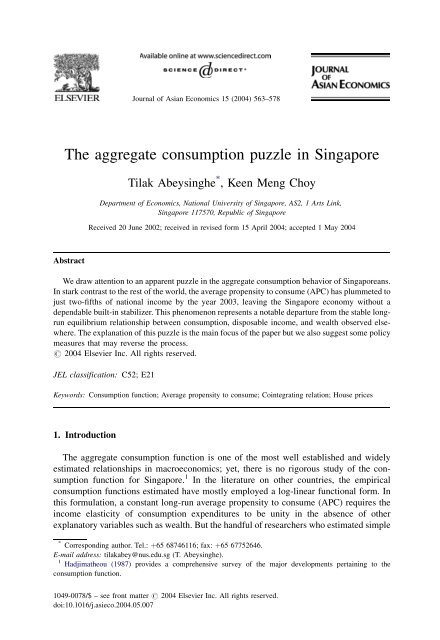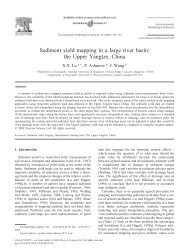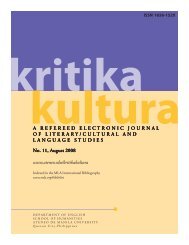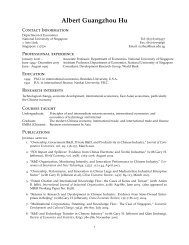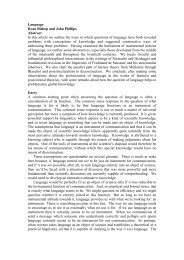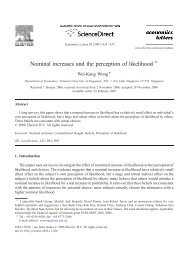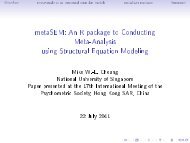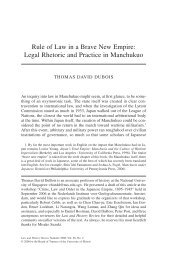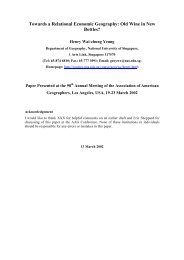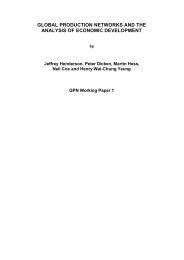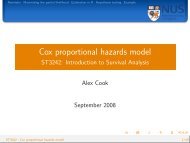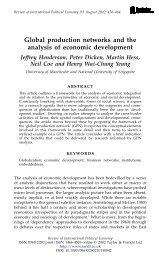The aggregate consumption puzzle in Singapore
The aggregate consumption puzzle in Singapore
The aggregate consumption puzzle in Singapore
Create successful ePaper yourself
Turn your PDF publications into a flip-book with our unique Google optimized e-Paper software.
<strong>The</strong> <strong>aggregate</strong> <strong>consumption</strong> <strong>puzzle</strong> <strong>in</strong> S<strong>in</strong>gapore<br />
Abstract<br />
Tilak Abeys<strong>in</strong>ghe * , Keen Meng Choy<br />
Department of Economics, National University of S<strong>in</strong>gapore, AS2, 1 Arts L<strong>in</strong>k,<br />
S<strong>in</strong>gapore 117570, Republic of S<strong>in</strong>gapore<br />
Received 20 June 2002; received <strong>in</strong> revised form 15 April 2004; accepted 1 May 2004<br />
We draw attention to an apparent <strong>puzzle</strong> <strong>in</strong> the <strong>aggregate</strong> <strong>consumption</strong> behavior of S<strong>in</strong>gaporeans.<br />
In stark contrast to the rest of the world, the average propensity to consume (APC) has plummeted to<br />
just two-fifths of national <strong>in</strong>come by the year 2003, leav<strong>in</strong>g the S<strong>in</strong>gapore economy without a<br />
dependable built-<strong>in</strong> stabilizer. This phenomenon represents a notable departure from the stable longrun<br />
equilibrium relationship between <strong>consumption</strong>, disposable <strong>in</strong>come, and wealth observed elsewhere.<br />
<strong>The</strong> explanation of this <strong>puzzle</strong> is the ma<strong>in</strong> focus of the paper but we also suggest some policy<br />
measures that may reverse the process.<br />
# 2004 Elsevier Inc. All rights reserved.<br />
JEL classification: C52; E21<br />
Keywords: Consumption function; Average propensity to consume; Co<strong>in</strong>tegrat<strong>in</strong>g relation; House prices<br />
1. Introduction<br />
Journal of Asian Economics 15 (2004) 563–578<br />
<strong>The</strong> <strong>aggregate</strong> <strong>consumption</strong> function is one of the most well established and widely<br />
estimated relationships <strong>in</strong> macroeconomics; yet, there is no rigorous study of the <strong>consumption</strong><br />
function for S<strong>in</strong>gapore. 1 In the literature on other countries, the empirical<br />
<strong>consumption</strong> functions estimated have mostly employed a log-l<strong>in</strong>ear functional form. In<br />
this formulation, a constant long-run average propensity to consume (APC) requires the<br />
<strong>in</strong>come elasticity of <strong>consumption</strong> expenditures to be unity <strong>in</strong> the absence of other<br />
explanatory variables such as wealth. But the handful of researchers who estimated simple<br />
*<br />
Correspond<strong>in</strong>g author. Tel.: þ65 68746116; fax: þ65 67752646.<br />
E-mail address: tilakabey@nus.edu.sg (T. Abeys<strong>in</strong>ghe).<br />
1<br />
Hadjimatheou (1987) provides a comprehensive survey of the major developments perta<strong>in</strong><strong>in</strong>g to the<br />
<strong>consumption</strong> function.<br />
1049-0078/$ – see front matter # 2004 Elsevier Inc. All rights reserved.<br />
doi:10.1016/j.asieco.2004.05.007
564 T. Abeys<strong>in</strong>ghe, K.M. Choy / Journal of Asian Economics 15 (2004) 563–578<br />
Fig. 1. <strong>The</strong> APC <strong>in</strong> S<strong>in</strong>gapore.<br />
<strong>consumption</strong> functions for S<strong>in</strong>gapore have obta<strong>in</strong>ed elasticities that are well below one,<br />
thus implicitly allow<strong>in</strong>g the APC to fall as <strong>in</strong>come <strong>in</strong>creases 2 (Lim & Associates, 1988,<br />
Chapter 16; Toh & Ramstetter, 1994; Wong, 1974).<br />
When the APC is measured as the ratio of real private <strong>consumption</strong> expenditures to real<br />
GDP <strong>in</strong> S<strong>in</strong>gapore, it has <strong>in</strong>deed fallen steadily over time from 0.80 <strong>in</strong> 1960 to 0.42 <strong>in</strong> 2003<br />
(Fig. 1). This has produced the lowest share of private <strong>consumption</strong> <strong>in</strong> output <strong>in</strong> the free<br />
world. Even amongst the former centrally planned economies, Ermisch and Huff (1999)<br />
noted that the lowest share of private <strong>consumption</strong> reached <strong>in</strong> the Soviet Union was 55%.<br />
<strong>The</strong> dramatic decl<strong>in</strong>e <strong>in</strong> the APC seems to have left the S<strong>in</strong>gapore economy without a<br />
dependable built-<strong>in</strong> stabilizer, which together with the higher volatility of external demand<br />
could have contributed to the <strong>in</strong>creased amplitudes of S<strong>in</strong>gapore’s bus<strong>in</strong>ess cycles <strong>in</strong> recent<br />
years.<br />
<strong>The</strong> long-term decl<strong>in</strong>e <strong>in</strong> the APC is puzzl<strong>in</strong>g and anomalous because s<strong>in</strong>ce Kuznets’<br />
(1946) pioneer<strong>in</strong>g work, it was observed that the APC is relatively stable <strong>in</strong> the long run.<br />
<strong>The</strong> post-war evidence on selected economies bear out this remarkable fact: Table 1 shows<br />
that the shares of private <strong>consumption</strong> <strong>in</strong> GDP of the United States and United K<strong>in</strong>gdom<br />
have hovered around two-thirds to three-quarters from 1960 to 2000. In Asia, Japan saw its<br />
APC fall dur<strong>in</strong>g the 1960s and 1970s—probably a reflection of the demographic transition—but<br />
the ratio has stabilized s<strong>in</strong>ce 1980; this trend was mimicked by Taiwan and Hong<br />
Kong. Switzerland, a mature <strong>in</strong>dustrialized economy, is perhaps the best comparison for<br />
S<strong>in</strong>gapore <strong>in</strong> view of its smallness and openness. As S<strong>in</strong>gapore reaches a stage of<br />
development that is comparable to Switzerland’s, one would expect its APC to stabilize.<br />
This, however, has not happened thus far.<br />
Historically, the life-cycle and permanent <strong>in</strong>come hypotheses were formulated precisely<br />
to expla<strong>in</strong> the stylized fact of a constant APC, as the simple Keynesian <strong>consumption</strong><br />
2 a 1 a Given the simple <strong>consumption</strong> function C ¼ AY , the APC is C=Y ¼ Að1=Y Þ.If0< a < 1, the APC will<br />
fall as <strong>in</strong>come rises.
T. Abeys<strong>in</strong>ghe, K.M. Choy / Journal of Asian Economics 15 (2004) 563–578 565<br />
Table 1<br />
APC <strong>in</strong> selected economies (real <strong>consumption</strong>/GDP ratio)<br />
function had implied that the APC should decrease over time with <strong>in</strong>creases <strong>in</strong> <strong>in</strong>come.<br />
Essentially, these explanations po<strong>in</strong>ted out the key role played by wealth and other human<br />
assets <strong>in</strong> ma<strong>in</strong>ta<strong>in</strong><strong>in</strong>g a stable ratio of <strong>consumption</strong> to GDP <strong>in</strong> the long run. <strong>The</strong> classic<br />
study on the US by Ando and Modigliani (1963), for example, showed that the stock of<br />
assets played the role of an <strong>in</strong>tercept term <strong>in</strong> their estimated <strong>consumption</strong> function, which<br />
progressively shifts the function upward as <strong>in</strong>come levels rise so as to trace out an APC that<br />
rema<strong>in</strong>s roughly unchanged <strong>in</strong> the long run.<br />
Previous S<strong>in</strong>gapore studies have excluded an appropriate wealth variable, cast<strong>in</strong>g doubt<br />
on the veracity of the estimated <strong>in</strong>come elasticities. However, it is the contention of this<br />
paper that textbook macroeconomic theories of <strong>consumption</strong> do not provide satisfactory<br />
explanations for the anomalous <strong>consumption</strong> behavior of S<strong>in</strong>gaporeans even when wealth<br />
is taken <strong>in</strong>to account. Our efforts to build an <strong>aggregate</strong> <strong>consumption</strong> function that<br />
<strong>in</strong>corporates a constant <strong>consumption</strong>–<strong>in</strong>come ratio <strong>in</strong> the long run led us to a search<br />
for the causes of the APC’s secular decl<strong>in</strong>e <strong>in</strong> S<strong>in</strong>gapore. We beg<strong>in</strong> this quest <strong>in</strong> Section 2<br />
by estimat<strong>in</strong>g a traditional <strong>consumption</strong> function that depends on disposable <strong>in</strong>come and<br />
wealth and show that it leads to an unstable APC. After review<strong>in</strong>g <strong>in</strong> Section 3 some rather<br />
implausible explanations put forward by studies on sav<strong>in</strong>gs behavior, we provide <strong>in</strong> Section<br />
4 a <strong>consumption</strong> equation which is capable of resolv<strong>in</strong>g the <strong>puzzle</strong> of S<strong>in</strong>gapore’s fall<strong>in</strong>g<br />
APC. In Section 5, we draw implications for policymakers and make some recommendations.<br />
2. <strong>The</strong> <strong>consumption</strong> <strong>puzzle</strong><br />
1960 1970 1980 1990 2000<br />
S<strong>in</strong>gapore 0.80 0.61 0.52 0.46 0.41<br />
US 0.68 0.69 0.66 0.68 0.68<br />
UK 0.73 0.69 0.72 0.75 0.77<br />
Japan 0.60 0.53 0.61 0.58 0.61<br />
Taiwan 0.64 0.62 0.57 0.61 0.60<br />
Hong Kong 0.69 0.65 0.64 0.65 0.64<br />
Switzerland 0.57 0.55 0.60 0.57 0.58<br />
Sources: S<strong>in</strong>gapore—authors’ calculation; Taiwan <strong>in</strong> 2000—Bureau of Statistics; other countries—Penn World<br />
Table 6.1.<br />
As the first step <strong>in</strong> model<strong>in</strong>g the <strong>consumption</strong> function, we shall exam<strong>in</strong>e the traditional<br />
relationship between <strong>aggregate</strong> private <strong>consumption</strong>, disposable <strong>in</strong>come, and wealth.<br />
S<strong>in</strong>gapore’s statistical data on private <strong>consumption</strong> expenditures are not broken down<br />
<strong>in</strong>to spend<strong>in</strong>g on consumer durables and non-durable goods and services; hence, we are<br />
forced to model <strong>aggregate</strong> expenditures without differentiat<strong>in</strong>g between these two important<br />
categories. Another drawback of us<strong>in</strong>g total <strong>consumption</strong> is that it <strong>in</strong>cludes expenditures<br />
on hous<strong>in</strong>g services <strong>in</strong> the form of imputed rents on owner-occupied dwell<strong>in</strong>gs, so
566 T. Abeys<strong>in</strong>ghe, K.M. Choy / Journal of Asian Economics 15 (2004) 563–578<br />
Fig. 2. Private <strong>consumption</strong>, real GDP and disposable <strong>in</strong>come.<br />
that an <strong>in</strong>crease <strong>in</strong> house prices will cause <strong>consumption</strong> to rise <strong>in</strong>dependently of any wealth<br />
effect.<br />
Official series for disposable <strong>in</strong>come and wealth are not available <strong>in</strong> S<strong>in</strong>gapore and<br />
therefore had to be constructed. We first calculate real disposable <strong>in</strong>come as:<br />
Yd ¼ GDP taxes government fees and charges net CPF contributions<br />
where taxes <strong>in</strong>clude both direct and <strong>in</strong>direct taxes, and Central Provident Fund (CPF)<br />
contributions are net of withdrawals. 3 <strong>The</strong> variables that enter <strong>in</strong>to the construction of the<br />
real disposable <strong>in</strong>come series are all expressed <strong>in</strong> real terms and where necessary, they are<br />
deflated by the Consumer Price Index (Pt). Fig. 2 plots real private <strong>consumption</strong><br />
expenditures, real GDP, and disposable <strong>in</strong>come us<strong>in</strong>g seasonally adjusted data beg<strong>in</strong>n<strong>in</strong>g<br />
from the first-quarter of 1978 and end<strong>in</strong>g at the last-quarter of 2003. <strong>The</strong> graph shows that<br />
the paths of <strong>consumption</strong> and <strong>in</strong>come tend to diverge <strong>in</strong> the long run, reflect<strong>in</strong>g the<br />
phenomenon of a fall<strong>in</strong>g APC <strong>in</strong> S<strong>in</strong>gapore.<br />
In contrast to disposable <strong>in</strong>come, household wealth can be constructed <strong>in</strong> a number of<br />
ways. If households diversify their wealth <strong>in</strong>to n assets, and Ait is the stock of the ith asset <strong>in</strong><br />
3 <strong>The</strong> quarterly data used <strong>in</strong> this study are sourced from the S<strong>in</strong>gapore Department of Statistics’ onl<strong>in</strong>e<br />
TREND database. Data on taxes and government fees and charges are only available on a quarterly basis start<strong>in</strong>g<br />
from 1988, so observations go<strong>in</strong>g back to 1978 had to be <strong>in</strong>terpolated from annual data us<strong>in</strong>g the Chow-L<strong>in</strong><br />
Technique (Abeys<strong>in</strong>ghe & Gulasekaran, 2003). <strong>The</strong> CPF is a mandatory sav<strong>in</strong>g scheme with contributions by<br />
both employers and employees. We add back to disposable <strong>in</strong>come all withdrawals from the CPF <strong>in</strong>clud<strong>in</strong>g those<br />
used for f<strong>in</strong>anc<strong>in</strong>g <strong>in</strong>vestment <strong>in</strong> residential construction.
nom<strong>in</strong>al terms, S it is the sav<strong>in</strong>gs that are channeled to the ith asset and p it is the rate of<br />
change of the price of the ith asset, then:<br />
Ait ¼ Sit þ Ait 1ð1 þ pitÞ: (1)<br />
Upon comput<strong>in</strong>g (1) for each asset, <strong>aggregate</strong> assets can be obta<strong>in</strong>ed by summ<strong>in</strong>g over the<br />
Ai terms. Alternatively, the total stock of assets can be written as:<br />
Xn " #<br />
Ait 1<br />
ð1 þ pitÞ ; (2)<br />
At ¼ St þ At 1<br />
At i¼1 1<br />
where At ¼ A1t þ A2t þ ...þ Ant, St ¼ S1t þ S2t þ ...þ Snt, and Ait 1=At 1 is the share of<br />
the ith asset <strong>in</strong> total wealth. If these shares rema<strong>in</strong> roughly constant over time, the term<br />
with<strong>in</strong> square brackets, which represents the <strong>aggregate</strong> revaluation term, can be worked out<br />
without much difficulty. Note that <strong>in</strong> the case of <strong>in</strong>terest bear<strong>in</strong>g assets, pit is the nom<strong>in</strong>al<br />
<strong>in</strong>terest rate.<br />
<strong>The</strong> wealth variable that we construct for S<strong>in</strong>gapore (Wt) has two major components,<br />
gross hous<strong>in</strong>g wealth (HW t) and f<strong>in</strong>ancial wealth (FW t). We derived the stock of hous<strong>in</strong>g<br />
assets <strong>in</strong> each period by revalu<strong>in</strong>g the previous period’s stock <strong>in</strong> l<strong>in</strong>e with changes <strong>in</strong> house<br />
prices as follows:<br />
HW n t<br />
¼ Inh<br />
t þ HWn t 1<br />
P h t<br />
P h t 1<br />
where HW n t is nom<strong>in</strong>al hous<strong>in</strong>g wealth, I nh<br />
t<br />
; (3)<br />
is nom<strong>in</strong>al <strong>in</strong>vestment expenditures on<br />
residential construction (obta<strong>in</strong>ed by multiply<strong>in</strong>g real expenditures by the hous<strong>in</strong>g<br />
<strong>in</strong>vestment deflator 4 ) and Ph t is the private residential property price <strong>in</strong>dex <strong>in</strong> S<strong>in</strong>gapore.<br />
<strong>The</strong> <strong>in</strong>itial value of the hous<strong>in</strong>g stock was taken to be S$10,344.7 million <strong>in</strong> 1975<br />
(computed from Rao & Lee, 1995).<br />
Due to the paucity of data on the sav<strong>in</strong>gs and <strong>in</strong>vestment patterns of households <strong>in</strong><br />
S<strong>in</strong>gapore, we consider only three types of f<strong>in</strong>ancial assets: CPF sav<strong>in</strong>gs, bank deposits (D)<br />
and equities (E). Hence, the <strong>aggregate</strong> nom<strong>in</strong>al stock of f<strong>in</strong>ancial wealth can be written as:<br />
FW n t<br />
T. Abeys<strong>in</strong>ghe, K.M. Choy / Journal of Asian Economics 15 (2004) 563–578 567<br />
¼ ACPF t þ ADt þ AEt : (4)<br />
Accumulated CPF sav<strong>in</strong>gs are directly measured by net CPF balances while data on the<br />
amount of bank sav<strong>in</strong>gs held by S<strong>in</strong>gapore residents are also available (both series <strong>in</strong>clude<br />
<strong>in</strong>terest payments). Assum<strong>in</strong>g that the residual sav<strong>in</strong>gs are largely <strong>in</strong>vested <strong>in</strong> local shares,<br />
we computed the equity stock us<strong>in</strong>g the follow<strong>in</strong>g two equations:<br />
S E t ¼ PtðYdt CtÞ I nh<br />
t S D t ; (5)<br />
A E t ¼ SE t þ AE t 1<br />
P E t<br />
P E t 1<br />
; (6)<br />
where SD t ¼ DADt and PEt is the Stock Exchange of S<strong>in</strong>gapore (SES) share price <strong>in</strong>dex. On<br />
account of the lower popularity of stock <strong>in</strong>vestment by households <strong>in</strong> the early years of the<br />
4<br />
<strong>The</strong> quarterly hous<strong>in</strong>g <strong>in</strong>vestment deflator was <strong>in</strong>terpolated from the annual series us<strong>in</strong>g the SAS spl<strong>in</strong>e<br />
method.
568 T. Abeys<strong>in</strong>ghe, K.M. Choy / Journal of Asian Economics 15 (2004) 563–578<br />
sample, the start<strong>in</strong>g value of equities is taken to be two-fifths of the amount of bank<br />
deposits at the end of 1976.<br />
Nom<strong>in</strong>al hous<strong>in</strong>g and f<strong>in</strong>ancial wealth were deflated by the CPI to arrive at their real<br />
counterparts, HW t and FW t. Fig. 3 plots each of these series and their sum, W t.<strong>The</strong><br />
figure shows that household wealth grew relatively slowly <strong>in</strong> the 1980s, picked up<br />
sharply <strong>in</strong> the 1990s as asset and house prices rose, and then fell dur<strong>in</strong>g the Asian<br />
f<strong>in</strong>ancial crisis of 1997–1998. Aggregate wealth rebounded strongly after the crisis, only<br />
to decl<strong>in</strong>e aga<strong>in</strong> with the onset of economic recession <strong>in</strong> 2001.Us<strong>in</strong>g the data series<br />
graphed <strong>in</strong> Figs. 2 and 3, OLS regressions of <strong>aggregate</strong> <strong>consumption</strong> expenditure on<br />
disposable <strong>in</strong>come and the different wealth variables for the period 1978Q1 to 2003Q4<br />
are reported below:<br />
ln Ct ¼ 1:06<br />
ð11:9Þ<br />
þ 0:64<br />
ð13:7Þ<br />
ln Ydt þ 0:14 ln Wt; (7)<br />
ð3:86Þ<br />
R 2 ¼ 0:988; SE ¼ 0:049; CRDW ¼ 0:28; ADF ¼ 2:21;<br />
ln Ct ¼ 1:22 þ 0:78<br />
ð12:6Þ ð26:8Þ ln Ydt þ 0:03<br />
ð1:63Þ ln HWt; (8)<br />
R 2 ¼ 0:987; SE ¼ 0:052; CRDW ¼ 0:29; ADF ¼ 1:96;<br />
ln Ct ¼ 0:88<br />
ð9:54Þ<br />
Fig. 3. Measures of household wealth <strong>in</strong> S<strong>in</strong>gapore.<br />
þ 0:49 ln Ydt þ 0:28<br />
ð8:44Þ ð5:85Þ ln FWt; (9)<br />
R 2 ¼ 0:990; SE ¼ 0:046; CRDW ¼ 0:34; ADF ¼ 2:93:
T. Abeys<strong>in</strong>ghe, K.M. Choy / Journal of Asian Economics 15 (2004) 563–578 569<br />
<strong>The</strong> numbers <strong>in</strong> parentheses are the t-statistics, CRDW is the co<strong>in</strong>tegrat<strong>in</strong>g regression<br />
Durb<strong>in</strong>–Watson statistic and ADF is the residual-based augmented Dickey–Fuller test<br />
statistic for co<strong>in</strong>tegration computed from an AR(2) regression. 5 <strong>The</strong> 5% critical value for<br />
the ADF test is 3.84 (MacK<strong>in</strong>non, 1991).<br />
<strong>The</strong> estimated <strong>in</strong>come elasticities seem to be rather low and vary substantially depend<strong>in</strong>g<br />
on the wealth variable employed. If regression (7) with <strong>aggregate</strong> wealth is used, the<br />
<strong>in</strong>come elasticity of 0.64 translates <strong>in</strong>to a marg<strong>in</strong>al propensity to consume (MPC) of about<br />
35 cents out of an additional dollar of disposable <strong>in</strong>come. <strong>The</strong> implied marg<strong>in</strong>al propensity<br />
to consume with respect to wealth is even smaller, at merely 3 cents per $100 of wealth. <strong>The</strong><br />
reason for this low estimate is found <strong>in</strong> (8): the <strong>in</strong>divisibility of the hous<strong>in</strong>g stock and<br />
limited avenues for realiz<strong>in</strong>g capital ga<strong>in</strong>s <strong>in</strong> the local property market mean that<br />
<strong>consumption</strong> expenditure is largely unaffected by hous<strong>in</strong>g wealth. F<strong>in</strong>ancial wealth, on<br />
the other hand, exerts a greater <strong>in</strong>fluence on <strong>consumption</strong>, though the results <strong>in</strong> (9) are far<br />
from satisfactory.<br />
None of the above regressions represent co<strong>in</strong>tegrat<strong>in</strong>g relations, imply<strong>in</strong>g that the OLS<br />
estimates are <strong>in</strong>consistent. When we impose the homogeneity restriction that the sum of the<br />
<strong>in</strong>come and wealth elasticities equals unity, the result<strong>in</strong>g logarithmic regression of the<br />
<strong>consumption</strong>–<strong>in</strong>come ratio on the wealth–<strong>in</strong>come ratio not only fails to co<strong>in</strong>tegrate, but<br />
also produces a negative wealth coefficient <strong>in</strong> every case. This f<strong>in</strong>d<strong>in</strong>g is yet another<br />
manifestation of the non-stationary APC ratio. <strong>The</strong> absence of co<strong>in</strong>tegration between<br />
<strong>consumption</strong> and <strong>in</strong>come even after allow<strong>in</strong>g for wealth effects constitutes the <strong>consumption</strong><br />
<strong>puzzle</strong> <strong>in</strong> S<strong>in</strong>gapore.<br />
3. Sav<strong>in</strong>gs and <strong>consumption</strong><br />
At this juncture, it might be useful to briefly review work that has been done on<br />
S<strong>in</strong>gapore’s <strong>aggregate</strong> sav<strong>in</strong>gs behavior <strong>in</strong> order to shed some light on the <strong>consumption</strong><br />
<strong>puzzle</strong>. 6 S<strong>in</strong>ce <strong>consumption</strong> is the flip side of sav<strong>in</strong>gs, the dramatic <strong>in</strong>crease <strong>in</strong> the private<br />
sav<strong>in</strong>g rate witnessed dur<strong>in</strong>g the last three decades will pari passu depress the APC. Husa<strong>in</strong><br />
(1995) attributes at least part of the rise <strong>in</strong> sav<strong>in</strong>g to growth <strong>in</strong> per capita <strong>in</strong>come, but there<br />
are two caveats to this explanation. First, as mentioned earlier, theories of <strong>consumption</strong><br />
behavior do not predict a decl<strong>in</strong><strong>in</strong>g APC <strong>in</strong> spite of <strong>in</strong>come growth, at least not over long<br />
spans of time. Indeed, Kuznets provided evidence to show that the sav<strong>in</strong>gs ratio <strong>in</strong> the<br />
economically developed countries had not changed much s<strong>in</strong>ce the middle of the n<strong>in</strong>eteenth<br />
century despite the large recorded <strong>in</strong>crease <strong>in</strong> per capita <strong>in</strong>come. <strong>The</strong> argument that<br />
the APC fell <strong>in</strong> S<strong>in</strong>gapore due to a rise <strong>in</strong> real <strong>in</strong>come per capita holds only if we restrict the<br />
time period to the ‘short run.’ However one def<strong>in</strong>es that, we th<strong>in</strong>k that the 40 years over<br />
which the APC has been halved is too long an <strong>in</strong>terval to satisfy the requirement.<br />
Second, it bears repeat<strong>in</strong>g the stylized fact that many fast grow<strong>in</strong>g economies—<br />
<strong>in</strong>clud<strong>in</strong>g the high sav<strong>in</strong>g newly <strong>in</strong>dustrialized economies of Taiwan and Hong<br />
5<br />
ADF tests for unit roots support the hypothesis that all the variables used <strong>in</strong> this exercise are I(1) but these<br />
results are not reported for brevity.<br />
6<br />
Chapter 4 of Peebles and Wilson (2002) conta<strong>in</strong>s a thorough review of the literature on sav<strong>in</strong>gs <strong>in</strong> S<strong>in</strong>gapore.
570 T. Abeys<strong>in</strong>ghe, K.M. Choy / Journal of Asian Economics 15 (2004) 563–578<br />
Kong—have not witnessed persistent decl<strong>in</strong>es <strong>in</strong> their APCs (Table 1). As we noted earlier,<br />
the <strong>in</strong>itial decl<strong>in</strong>es experienced by these countries <strong>in</strong> the 1960s and 1970s are likely to have<br />
been caused by demographic shifts affect<strong>in</strong>g their work<strong>in</strong>g populations—an explanation<br />
emphasized by the proponents of life-cycle theory themselves (Ando & Modigliani, 1963).<br />
Demographic change has <strong>in</strong> fact been cited as another important factor expla<strong>in</strong><strong>in</strong>g the<br />
upward trend <strong>in</strong> S<strong>in</strong>gapore’s private sav<strong>in</strong>g rate (Husa<strong>in</strong>, 1995; Monetary Authority of<br />
S<strong>in</strong>gapore, 1993). It was argued that the susta<strong>in</strong>ed period of growth experienced by<br />
S<strong>in</strong>gapore co<strong>in</strong>cided with a significant fall <strong>in</strong> both young and old dependents <strong>in</strong> the<br />
population. However, the statistics suggest that if this had any role to play at all <strong>in</strong><br />
expla<strong>in</strong><strong>in</strong>g the APC, it cannot be beyond the mid-1980s, when the ratio of the work<strong>in</strong>g age<br />
population to the total population stabilized at 70%. Yet the APC has cont<strong>in</strong>ued its<br />
precipitous decl<strong>in</strong>e <strong>in</strong> the 1990s.<br />
In a provocative article, Ermisch and Huff (1999) claimed that forced sav<strong>in</strong>g <strong>in</strong><br />
S<strong>in</strong>gapore, extracted through compulsory CPF contributions and the manipulation of<br />
the <strong>in</strong>ternal terms of trade by the major statutory boards provid<strong>in</strong>g utilities and telecommunication<br />
services, have been responsible for the high sav<strong>in</strong>gs rate and hence for<br />
‘‘spectacular drops <strong>in</strong> <strong>consumption</strong> as a share of GDP’’ (p. 30). But it will do well to<br />
remember that private <strong>consumption</strong> as a share of disposable <strong>in</strong>come, and not just GDP, has<br />
also exhibited a pronounced downward trend. Given the way we have measured disposable<br />
<strong>in</strong>come, this suggests that ris<strong>in</strong>g CPF contributions and <strong>in</strong>creases <strong>in</strong> government fees and<br />
charges could not have been the reasons beh<strong>in</strong>d the APC’s decl<strong>in</strong>e. By the same token, high<br />
personal <strong>in</strong>come taxes are not a feasible explanation; as a matter of fact, tax rates have been<br />
progressively reduced over the years. However, <strong>in</strong>creases <strong>in</strong> the CPF contribution rate, by<br />
reduc<strong>in</strong>g disposable <strong>in</strong>come, might have <strong>in</strong>duced people to save more for precautionary<br />
purposes or to meet unexpected cont<strong>in</strong>gencies. We tested this hypothesis of ‘forced sav<strong>in</strong>g’<br />
through the CPF by <strong>in</strong>troduc<strong>in</strong>g the overall CPF contribution rate <strong>in</strong>to the standard<br />
<strong>consumption</strong> function. As expected, its impact was <strong>in</strong>significant.<br />
A potentially important determ<strong>in</strong>ant of sav<strong>in</strong>gs behavior which has not been considered<br />
by exist<strong>in</strong>g studies is the rate of <strong>in</strong>terest (Bl<strong>in</strong>der & Deaton, 1985). In theory, the after-tax<br />
real <strong>in</strong>terest rate is the relative price that <strong>in</strong>fluences <strong>in</strong>tertemporal substitution between<br />
present and future <strong>consumption</strong>. Hence, <strong>consumption</strong> is expected to be negatively related<br />
to movements <strong>in</strong> the real <strong>in</strong>terest rate. Moreover, Deaton (1977) has hypothesized that<br />
unexpected <strong>in</strong>flation could lead to decreases <strong>in</strong> consumer spend<strong>in</strong>g because households<br />
mistake nom<strong>in</strong>al price <strong>in</strong>creases for real price <strong>in</strong>creases. In particular, an absolute rise <strong>in</strong> the<br />
price of all goods and services is confused with a relative price rise for the good that the<br />
consumer is consider<strong>in</strong>g buy<strong>in</strong>g.<br />
S<strong>in</strong>ce it is difficult to calculate the effective tax rate on <strong>in</strong>terest <strong>in</strong>come <strong>in</strong> S<strong>in</strong>gapore, we<br />
<strong>in</strong>vestigated the sensitivity of <strong>consumption</strong> to changes <strong>in</strong> the pre-tax real <strong>in</strong>terest rate. <strong>The</strong><br />
latter is computed as the difference between the prime lend<strong>in</strong>g rate and the annual rate of<br />
change of the CPI—a crude, albeit convenient, proxy for expected <strong>in</strong>flation. We simultaneously<br />
perform a simple test of the ‘‘Deaton effect’’ by add<strong>in</strong>g both the real <strong>in</strong>terest rate<br />
and the actual <strong>in</strong>flation rate as arguments to the <strong>consumption</strong> function. Although the real<br />
<strong>in</strong>terest rate appears to be significant, <strong>in</strong>flation clearly is not, thus reject<strong>in</strong>g Deaton’s<br />
hypothesis. This result is perhaps not surpris<strong>in</strong>g given S<strong>in</strong>gapore’s low<strong>in</strong>flation record<br />
(except for the spikes <strong>in</strong> prices caused by the oil shocks <strong>in</strong> the 1970s). Still, no evidence of
co<strong>in</strong>tegration could be found. <strong>The</strong> answer to the S<strong>in</strong>gapore <strong>consumption</strong> <strong>puzzle</strong> has to be<br />
sought elsewhere.<br />
4. Expla<strong>in</strong><strong>in</strong>g the <strong>puzzle</strong><br />
T. Abeys<strong>in</strong>ghe, K.M. Choy / Journal of Asian Economics 15 (2004) 563–578 571<br />
Fig. 4. <strong>The</strong> nexus between house prices, f<strong>in</strong>ancial assets and <strong>consumption</strong>.<br />
<strong>The</strong> analyses <strong>in</strong> the previous sections suggest that the search for an explanation of the<br />
APC’s long-term decl<strong>in</strong>e <strong>in</strong> S<strong>in</strong>gapore must extend beyond the traditional variables. It<br />
requires an exam<strong>in</strong>ation of the peculiar circumstances <strong>in</strong> which S<strong>in</strong>gaporean households<br />
f<strong>in</strong>d themselves, <strong>in</strong> particular, the dramatic <strong>in</strong>creases <strong>in</strong> house and car prices seen <strong>in</strong> the<br />
1980s and the first half of the 1990s. Even the most affordable public apartments <strong>in</strong><br />
S<strong>in</strong>gapore could cost 5–10 times the average annual household <strong>in</strong>come while car prices<br />
stand as the highest <strong>in</strong> the world. House and car price <strong>in</strong>flation <strong>in</strong> S<strong>in</strong>gapore can <strong>in</strong> turn be<br />
traced to the limited land space, the ris<strong>in</strong>g aspirations of the population to upgrade to better<br />
hous<strong>in</strong>g, and the demand for cars outstripp<strong>in</strong>g the supply of quotas for car ownership.<br />
S<strong>in</strong>ce house prices appear to be the key to unlock<strong>in</strong>g the APC <strong>puzzle</strong> <strong>in</strong> S<strong>in</strong>gapore, it is<br />
worth look<strong>in</strong>g <strong>in</strong>to their l<strong>in</strong>ks with <strong>consumption</strong> expenditures on non-hous<strong>in</strong>g goods and<br />
services <strong>in</strong> detail. Fig. 4 shows this nexus. A young couple <strong>in</strong> S<strong>in</strong>gapore typically starts a<br />
family by <strong>in</strong>itially buy<strong>in</strong>g a Hous<strong>in</strong>g Development Board (HDB) three-room flat and then<br />
upgrad<strong>in</strong>g later to a larger HDB apartment or to private hous<strong>in</strong>g as their <strong>in</strong>come and<br />
f<strong>in</strong>ancial assets grow. 7 Although hous<strong>in</strong>g wealth grows <strong>in</strong> l<strong>in</strong>e with <strong>in</strong>creases <strong>in</strong> house<br />
prices, the sav<strong>in</strong>gs locked up <strong>in</strong> a house cannot be easily converted <strong>in</strong>to the <strong>consumption</strong> of<br />
non-hous<strong>in</strong>g goods and services. Coupled with a lack of f<strong>in</strong>ancial <strong>in</strong>struments like reverse<br />
mortgages <strong>in</strong> S<strong>in</strong>gapore, this means that hous<strong>in</strong>g assets are effectively illiquid (as<br />
7 <strong>The</strong> HDB is the statutory board responsible for the provision of subsidized public hous<strong>in</strong>g <strong>in</strong> S<strong>in</strong>gapore.<br />
About four-fifths of S<strong>in</strong>gapore residents live <strong>in</strong> HDB flats and the rest <strong>in</strong> private hous<strong>in</strong>g (condom<strong>in</strong>iums, semidetached,<br />
and detached houses). S<strong>in</strong>gapore citizens are eligible to buy new HDB flats at subsidized rates from<br />
the government though <strong>in</strong> the past, this usually entails a long wait<strong>in</strong>g period.
572 T. Abeys<strong>in</strong>ghe, K.M. Choy / Journal of Asian Economics 15 (2004) 563–578<br />
confirmed by our regression results). For this reason, we have crossed the l<strong>in</strong>k from these<br />
assets to <strong>consumption</strong> <strong>in</strong> Fig. 4.<br />
Unlike <strong>in</strong> bigger countries, there are no cheap suburbs <strong>in</strong> S<strong>in</strong>gapore where one could buy<br />
a similar or better house and enjoy the capital ga<strong>in</strong>s from the sale of the exist<strong>in</strong>g one. <strong>The</strong><br />
sole option available to S<strong>in</strong>gaporeans, apart from emigration to other countries, is to<br />
downgrade to a smaller unit. Direct downgrad<strong>in</strong>g from private hous<strong>in</strong>g to HDB apartments<br />
appears to be uncommon because of psychological resistance and a segmented hous<strong>in</strong>g<br />
market, especially <strong>in</strong> terms of the amenities provided by private estates. However,<br />
downgrad<strong>in</strong>g takes place <strong>in</strong> a more subtle way. <strong>The</strong> fact that about 85% of elderly parents<br />
live with their children suggests that parents might move <strong>in</strong>to a smaller flat with their<br />
children <strong>in</strong> their old age. In this case, the parental house or the proceeds from its sale are<br />
passed on to their descendants <strong>in</strong> the form of bequests.<br />
As house prices go up, the <strong>in</strong>crease <strong>in</strong> the value of hous<strong>in</strong>g assets is accompanied by a<br />
concurrent rise <strong>in</strong> the f<strong>in</strong>ancial liabilities of households, <strong>in</strong> the form of higher down<br />
payments for the purchase of residential properties and burgeon<strong>in</strong>g hous<strong>in</strong>g loans. Due to<br />
the limited avenues for liquidat<strong>in</strong>g house assets, households have to build up sufficient<br />
f<strong>in</strong>ancial assets to smooth the profiles of their lifetime <strong>consumption</strong> of non-hous<strong>in</strong>g goods<br />
and services. In Fig. 4, the dotted arrow from hous<strong>in</strong>g loans to f<strong>in</strong>ancial assets shows this<br />
<strong>in</strong>direct l<strong>in</strong>k. While an <strong>in</strong>crease <strong>in</strong> household f<strong>in</strong>ancial wealth is likely to have a positive<br />
impact on <strong>consumption</strong>, part of the build-up <strong>in</strong> f<strong>in</strong>ancial assets occurs because of the<br />
illiquid nature of house assets. <strong>The</strong> implication is that, as house prices rise over time <strong>in</strong><br />
S<strong>in</strong>gapore, the <strong>consumption</strong> profiles chosen by later generations of households do not<br />
<strong>in</strong>crease as fast as their <strong>in</strong>come. <strong>The</strong>refore, one has to control for this effect <strong>in</strong> a regression<br />
to avoid the problem of omitted variable bias.<br />
<strong>The</strong> negative effect on <strong>consumption</strong> of an <strong>in</strong>crease <strong>in</strong> house prices work<strong>in</strong>g through the<br />
loans channel is also <strong>in</strong>dicated <strong>in</strong> Fig. 4. <strong>The</strong>re is some empirical evidence for this direct<br />
l<strong>in</strong>k: Phang (2004) found that anticipated house price <strong>in</strong>creases have a dampen<strong>in</strong>g effect on<br />
<strong>aggregate</strong> <strong>consumption</strong> <strong>in</strong> S<strong>in</strong>gapore, although the impact is statistically <strong>in</strong>significant. She<br />
attributes the f<strong>in</strong>d<strong>in</strong>g to what she called the ‘‘negative wealth effect’’ of price <strong>in</strong>creases on<br />
those seek<strong>in</strong>g to enter the hous<strong>in</strong>g market or to upgrade to better hous<strong>in</strong>g (Ludwig & Sløk,<br />
2002 refer to this as a ‘‘substitution effect’’). S<strong>in</strong>ce both wealth and substitution effects<br />
have to be non-negative for a normal good and for lack of a better name, we call the<br />
negative impact of a rise <strong>in</strong> house prices the ‘‘price effect.’’<br />
<strong>The</strong> price effect is likely to be well captured by a loans variable. Unfortunately, a time<br />
series on hous<strong>in</strong>g loans is not available <strong>in</strong> S<strong>in</strong>gapore. A composite variable made up of<br />
loans for build<strong>in</strong>gs, construction, and hous<strong>in</strong>g was found to be less appropriate. <strong>The</strong> best<br />
proxy for hous<strong>in</strong>g loans we can f<strong>in</strong>d is withdrawals from the CPF to f<strong>in</strong>ance the purchases<br />
of houses and mortgages. 8 To capture other loans, <strong>in</strong>clud<strong>in</strong>g car loans, we used data on<br />
bank lend<strong>in</strong>g to professional and private <strong>in</strong>dividuals. <strong>The</strong>se two loan variables, after<br />
deflat<strong>in</strong>g by the CPI, are found <strong>in</strong> prelim<strong>in</strong>ary <strong>in</strong>vestigations to have negative effects on<br />
8 Withdrawals from the CPF to pay for publicly built flats have been allowed s<strong>in</strong>ce 1968; <strong>in</strong> 1981, the rules<br />
were liberalized to cover private residential properties. <strong>The</strong> <strong>in</strong>crease <strong>in</strong> such withdrawals have been particularly<br />
rapid s<strong>in</strong>ce the early 1980s, hav<strong>in</strong>g grown from 2.8% of disposable <strong>in</strong>come <strong>in</strong> 1977 to 6.4% by 2000; as a<br />
proportion of CPF contributions, they have averaged about 40% dur<strong>in</strong>g the 1990s.
Table 2<br />
APC regression results<br />
T. Abeys<strong>in</strong>ghe, K.M. Choy / Journal of Asian Economics 15 (2004) 563–578 573<br />
OLS DOLS Johansen<br />
(1) (2) (3)<br />
F<strong>in</strong>ancial wealth 0.09 (1.99) 0.13 (2.38) 0.11 (2.81) 0.16 (2.25) 0.17 (2.11)<br />
Hous<strong>in</strong>g wealth 0.02 (0.88) – – – –<br />
Loans 0.18 ( 7.74) 0.26 ( 13.7) 0.17 ( 9.94) 0.22 ( 5.71) 0.17 ( 5.04)<br />
Visitor expenditures 0.18 (7.91) – 0.19 (9.72) 0.19 (6.50) 0.16 (4.12)<br />
R 2<br />
0.868 0.741 0.867 – –<br />
SE 0.041 0.057 0.041 – –<br />
CRDW 0.74 0.42 0.73 – –<br />
ADF 3.44 2.51 4.68 *<br />
– –<br />
Notes. Figures <strong>in</strong> parentheses are t-statistics; the corrected statistics for the DOLS estimates are computed from<br />
an AR(1) regression on the residuals. <strong>The</strong> ADF statistics <strong>in</strong> (1) and (2) are based on AR(2) regressions of<br />
residuals and the one <strong>in</strong> (3) is based on an AR(1) regression.<br />
*<br />
Significant at the 1% level.<br />
<strong>consumption</strong> which are roughly equal <strong>in</strong> magnitude. We therefore comb<strong>in</strong>ed them to form a<br />
total loans variable (Lt).<br />
Apart from disposable <strong>in</strong>come, f<strong>in</strong>ancial wealth and loans, we needed another variable to<br />
fully expla<strong>in</strong> the fall <strong>in</strong> the APC. This variable, aga<strong>in</strong> peculiar to S<strong>in</strong>gapore, is total visitor<br />
expenditures <strong>in</strong> real terms (Vt). 9 In pr<strong>in</strong>ciple, visitor expenditures should be irrelevant as<br />
private <strong>consumption</strong> is def<strong>in</strong>ed as expenditures by the resident population on the purchases<br />
of f<strong>in</strong>al goods and services. It is obta<strong>in</strong>ed by nett<strong>in</strong>g out the expenditures of tourists from<br />
the estimates of total <strong>consumption</strong> <strong>in</strong> the domestic market. However, the fact that the<br />
number of visitors who visit S<strong>in</strong>gapore each year is nearly twice the size of the resident<br />
population means that any errors-<strong>in</strong>-variables problem created by visitor spend<strong>in</strong>g would<br />
be amplified. That visitor expenditures turned out to be critical <strong>in</strong> our regressions po<strong>in</strong>ts to a<br />
residual element of tourist spend<strong>in</strong>g <strong>in</strong> the <strong>aggregate</strong> <strong>consumption</strong> data.<br />
<strong>The</strong> regression that we estimate us<strong>in</strong>g the variables discussed above is as follows:<br />
ln Ct<br />
¼ b0 þ b2 ln<br />
Ydt<br />
FWt<br />
þ b3 ln<br />
Ydt<br />
Lt<br />
þ b4 ln<br />
Ydt<br />
Vt<br />
þ ut; (10)<br />
Ydt<br />
with an implied <strong>in</strong>come elasticity of b1 ¼ 1 b2 b3 b4. This regression has a<br />
nice <strong>in</strong>terpretation—the dependent variable is the logarithm of the APC while the<br />
<strong>in</strong>dependent variables are the respective ratios of f<strong>in</strong>ancial wealth, loans, and visitor<br />
expenditures to disposable <strong>in</strong>come, also expressed <strong>in</strong> logarithms. If the specification leads<br />
to a co<strong>in</strong>tegrat<strong>in</strong>g regression, we would have obta<strong>in</strong>ed a constant APC <strong>in</strong> the long run or put<br />
9 Total visitor expenditures are obta<strong>in</strong>ed by multiply<strong>in</strong>g the number of visitor days by the average expenditure<br />
per visitor per day over the period 1985–1998 ($230). We use the period average because expenditure data are<br />
only available on an annual basis from 1985 and <strong>in</strong>terpolation of these annual statistics to obta<strong>in</strong> quarterly<br />
figures may <strong>in</strong>troduce further measurement errors. Over the period concerned, average visitor expenditure per<br />
day has gone up from $190 <strong>in</strong> 1985 to $314 <strong>in</strong> 1990 and then fallen steadily to $206 <strong>in</strong> 1998. Somewhat<br />
reluctantly, we have to ignore these fluctuations.
574 T. Abeys<strong>in</strong>ghe, K.M. Choy / Journal of Asian Economics 15 (2004) 563–578<br />
0.7<br />
0.6<br />
0.5<br />
0.8<br />
0.6<br />
0.4<br />
0.2<br />
APC<br />
198 198 199 199 200<br />
loan<br />
198 198 199 199 200<br />
22.<br />
20.<br />
17.<br />
15.<br />
0.0<br />
0.0<br />
0.0<br />
Fig. 5. <strong>The</strong> APC and key ratios.<br />
f<strong>in</strong>ancial wealth<br />
198 198 199 199 200<br />
visitor expenditure<br />
198 198 199 199 200<br />
differently, a unitary <strong>in</strong>come elasticity conditional on constant wealth–<strong>in</strong>come, loan–<br />
<strong>in</strong>come, and visitor expenditure–<strong>in</strong>come ratios.<br />
<strong>The</strong> regression results for (10) are shown <strong>in</strong> column (3) of Table 2 (the estimate of the<br />
constant term is not reported). <strong>The</strong> residual-based ADF t-statistic of 4.68 is significant at<br />
the 1% level accord<strong>in</strong>g to the MacK<strong>in</strong>non (1991) critical value; hence, this test renders<br />
strong support for co<strong>in</strong>tegration. For comparison, we show <strong>in</strong> columns (1) and (2)<br />
regressions that either <strong>in</strong>clude the hous<strong>in</strong>g wealth variable or omit the visitor expenditures<br />
variable. <strong>The</strong> <strong>in</strong>significance of the hous<strong>in</strong>g wealth coefficient re<strong>in</strong>forces the earlier<br />
regression f<strong>in</strong>d<strong>in</strong>gs and v<strong>in</strong>dicates our belief that hous<strong>in</strong>g assets <strong>in</strong> S<strong>in</strong>gapore are perceived<br />
to be illiquid. Furthermore, the ADF t-statistics associated with these regressions <strong>in</strong>dicate<br />
that they do not represent co<strong>in</strong>tegrat<strong>in</strong>g relationships.<br />
In order to correct for possible endogeneity and measurement-error biases of the OLS<br />
estimates and their standard errors, we employed the ‘dynamic OLS’ (DOLS) procedure<br />
popularized byStockandWatson(1993)tore-estimate(10)(seeHayashi,2000,pp.654–657).<br />
We set the lead and lag lengths <strong>in</strong> the dynamic regression to four-quarters, correspond<strong>in</strong>g<br />
roughly to the T 1/3 rule, and ran an AR(1) regression on the residuals to compute the long-run<br />
variance. Table 2 shows that the DOLS coefficient estimates on f<strong>in</strong>ancial wealth and loans are<br />
larger than <strong>in</strong> the OLS case and reassur<strong>in</strong>gly, they come with significant corrected t-statistics.<br />
F<strong>in</strong>ally, we used the Johansen (1988) maximum likelihood procedure for further test<strong>in</strong>g<br />
and estimation. <strong>The</strong> trace test, based on a VAR(2) specification for the four variables,<br />
supports the existence of a s<strong>in</strong>gle co<strong>in</strong>tegrat<strong>in</strong>g vector. Further test<strong>in</strong>g shows that the
T. Abeys<strong>in</strong>ghe, K.M. Choy / Journal of Asian Economics 15 (2004) 563–578 575<br />
wealth, loan, and visitor expenditure ratios are weakly exogenous for the parameters of<br />
<strong>in</strong>terest. This offers a justification for estimat<strong>in</strong>g a s<strong>in</strong>gle equation dynamic <strong>consumption</strong><br />
function, which we present later. <strong>The</strong> last column of Table 2 shows that the estimated longrun<br />
coefficients <strong>in</strong> the co<strong>in</strong>tegrat<strong>in</strong>g vector are similar to those from the DOLS regression.<br />
We use the DOLS estimates <strong>in</strong> the rest of our analysis. <strong>The</strong> <strong>in</strong>come elasticity of<br />
<strong>consumption</strong> implied by these estimates is 0.87, somewhat lower than the usual elasticities<br />
reported <strong>in</strong> the literature but higher than the estimates from regressions (7)–(9) and those<br />
found by previous S<strong>in</strong>gapore researchers. Us<strong>in</strong>g these results, we are able to derive an expost<br />
explanation of the APC’s decl<strong>in</strong>e. <strong>The</strong> estimated long-run elasticities suggest that a<br />
1% <strong>in</strong>crease <strong>in</strong> the f<strong>in</strong>ancial wealth ratio raises the APC by 0.16%, a similar <strong>in</strong>crease <strong>in</strong> the<br />
loan ratio reduces it by 0.22%, while a 1% decrease <strong>in</strong> the visitor expenditure ratio reduces<br />
it by 0.19%. Perhaps not surpris<strong>in</strong>gly, the price effect dom<strong>in</strong>ates the wealth effect, thereby<br />
expla<strong>in</strong><strong>in</strong>g the secular fall <strong>in</strong> the APC. Even if the wealth and loan coefficients are taken to<br />
be of the same magnitude as <strong>in</strong> the Johansen estimates <strong>in</strong> Table 2, the observed steeper<br />
trend <strong>in</strong> the loan ratio has more than offset the wealth effect and thereby exerted a<br />
downward pressure on the APC.<br />
Fig. 5 charts the historical evolution of the three key ratios and their impact on the APC.<br />
<strong>The</strong> superimposed regression trend l<strong>in</strong>es show that the ratio of household f<strong>in</strong>ancial wealth<br />
to disposable <strong>in</strong>come has an upward trend, but this <strong>in</strong>crease <strong>in</strong> the wealth ratio has not been<br />
sufficient to stem the decl<strong>in</strong>e <strong>in</strong> S<strong>in</strong>gapore’s APC, which has been driven by a sharply ris<strong>in</strong>g<br />
loan ratio and a decl<strong>in</strong><strong>in</strong>g visitor expenditure ratio. S<strong>in</strong>ce the number of visitors hosted by<br />
S<strong>in</strong>gapore has risen steadily over time, the fall<strong>in</strong>g visitor expenditure ratio is a direct<br />
reflection of the drop <strong>in</strong> average visitor expenditures. This structural trend has <strong>in</strong>advertently<br />
found its way <strong>in</strong>to the official estimates of private <strong>consumption</strong>, as we expla<strong>in</strong>ed earlier.<br />
However, it is evident from Fig. 5 that the decl<strong>in</strong><strong>in</strong>g visitor expenditure ratio is not the sole,<br />
or even the most critical, reason for the secular decl<strong>in</strong>e <strong>in</strong> the APC.<br />
We have thus far concentrated on model<strong>in</strong>g the long-term behavior of private <strong>consumption</strong><br />
expenditures <strong>in</strong> S<strong>in</strong>gapore. But do short-run fluctuations <strong>in</strong> <strong>consumption</strong> also<br />
respond to the long-run factors that are found to be important? To answer this question and<br />
close our analysis, we present below the error-correction model estimated for <strong>aggregate</strong><br />
<strong>consumption</strong>, <strong>in</strong> which the ECM term is simply the residuals computed from the DOLS<br />
estimates <strong>in</strong> Table 2:<br />
Dln Ct ¼ 0:14<br />
ð 5:43Þ<br />
0:26<br />
ð 3:12Þ<br />
D lnCt 1 þ 0:25D<br />
lnYdt þ 0:08D<br />
ln FWt<br />
ð4:03Þ<br />
ð2:34Þ<br />
0:03 D ln H<br />
ð 2:04Þ<br />
CPF<br />
t 1<br />
0:24<br />
ð5:90Þ ECMt 1; (11)<br />
R 2 ¼ 0:376; SE ¼ 0:018; DW ¼ 1:96:<br />
LM(5) ¼ 0.41 (0.84) ARCH(4) ¼ 1.25 (0.30) Normality ¼ 0.69 (0.71)<br />
Heteroscedasticity ¼ 1.01 (0.44) RESET ¼ 0.30 (0.59)<br />
In this regression, we tried the total loans variable and its components (CPF hous<strong>in</strong>g<br />
withdrawals and loans to <strong>in</strong>dividuals) separately, but only CPF hous<strong>in</strong>g withdrawals (H CPF )<br />
turned out to be statistically significant. <strong>The</strong> diagnostic test statistics (P-values <strong>in</strong>
576 T. Abeys<strong>in</strong>ghe, K.M. Choy / Journal of Asian Economics 15 (2004) 563–578<br />
parentheses) <strong>in</strong>dicate that the ECM formulation is satisfactory while the recursive<br />
parameter estimates of the model are remarkably stable.<br />
<strong>The</strong> error-correction model speaks for itself but we would like to highlight some<br />
observations. First, the short-run elasticity estimates are smaller than the long-run<br />
estimates given <strong>in</strong> Table 2. Second, it seems to be the case that the price effect is more<br />
of a long-run effect than a short-run one. Third, unlike the <strong>consumption</strong> functions estimated<br />
for the UK and the USA, S<strong>in</strong>gapore’s <strong>consumption</strong> expenditure is subject to more shortterm<br />
variation as reflected by the negative coefficient on D ln Ct 1. Fourth, the estimated<br />
ECM coefficient implies a moderate pace of adjustment to the long run, with about 24% of<br />
the short-term disequilibrium <strong>in</strong> last period’s <strong>consumption</strong> expenditures be<strong>in</strong>g elim<strong>in</strong>ated<br />
<strong>in</strong> the current quarter.<br />
5. Policy implications<br />
Fig. 6. Unadjusted and adjusted APC.<br />
We conclude this paper by draw<strong>in</strong>g out the policy implications of the forego<strong>in</strong>g analysis.<br />
Before that, it should be po<strong>in</strong>ted out that due to ‘measurement error’ caused by tourist<br />
spend<strong>in</strong>g, the APC <strong>in</strong> S<strong>in</strong>gapore is underestimated. Although we do not want to engage <strong>in</strong><br />
second guess<strong>in</strong>g the published data, we could not resist perform<strong>in</strong>g the follow<strong>in</strong>g counterfactual<br />
experiment: how much higher would it have been if the rema<strong>in</strong><strong>in</strong>g effect of visitor<br />
expenditures was purged from the data? <strong>The</strong> easiest way to answer the question is to divide<br />
Ct/Ydt by (Vt/Ydt) 0.19 to obta<strong>in</strong> an adjusted APC. However, the series adjusted <strong>in</strong> this way<br />
needs to be re-scaled and we did this by sett<strong>in</strong>g the adjusted APC to be the same as the<br />
unadjusted one <strong>in</strong> the first-quarter of 1978. Fig. 6 plots both the unadjusted and adjusted<br />
APCs (four-quarter mov<strong>in</strong>g averages are used to smooth out the fluctuations). <strong>The</strong>
discrepancy between the two average propensities to consume is small <strong>in</strong> the early years<br />
but it widened <strong>in</strong> the last decade. Interest<strong>in</strong>gly, the adjusted APC, apart from large cyclical<br />
fluctuations, shows only a mild downward trend s<strong>in</strong>ce 1985. Nonetheless, it appears that the<br />
decl<strong>in</strong>e <strong>in</strong> the visitor expenditures to <strong>in</strong>come ratio has only been partially responsible for<br />
the fall <strong>in</strong> the APC.<br />
Why should the fall<strong>in</strong>g APC be a cause for concern? It is a fact <strong>in</strong> most countries,<br />
S<strong>in</strong>gapore not excluded, that private <strong>consumption</strong> expenditures constitute the most stable<br />
component of f<strong>in</strong>al <strong>aggregate</strong> demand. With a decl<strong>in</strong><strong>in</strong>g APC, the more variable components<br />
<strong>in</strong> <strong>aggregate</strong> demand such as <strong>in</strong>vestment and exports become dom<strong>in</strong>ant <strong>in</strong> cyclical<br />
fluctuations. This results <strong>in</strong> more volatile GDP growth, ceteris paribus. In particular, as a<br />
small open economy, S<strong>in</strong>gapore is highly vulnerable to external shocks affect<strong>in</strong>g her<br />
domestic exports. Dur<strong>in</strong>g such times, measures to stimulate consumer spend<strong>in</strong>g will not be<br />
very potent given that private <strong>consumption</strong> expenditures currently account for less than half<br />
of GDP. In other words, <strong>consumption</strong> spend<strong>in</strong>g cannot serve as a built-<strong>in</strong> stabilizer for the<br />
economy unless the government takes measures to raise the share of such expenditures <strong>in</strong><br />
output.<br />
<strong>The</strong> ma<strong>in</strong> result of our study is that ris<strong>in</strong>g loans and withdrawals from the CPF to f<strong>in</strong>ance<br />
house and car purchases have played a crucial role <strong>in</strong> the evolution of S<strong>in</strong>gapore’s APC. It<br />
is observable that a fall <strong>in</strong> house prices is accompanied by a rise <strong>in</strong> APC with a lag of 4–5<br />
years. This leads us to another important policy implication: to prevent further decl<strong>in</strong>es <strong>in</strong><br />
the APC, the government should ensure that residential property and other household assets<br />
rema<strong>in</strong> affordable to S<strong>in</strong>gaporeans. At the least, it should do its best to prevent a recurrence<br />
of the bubble-like <strong>in</strong>creases <strong>in</strong> residential property prices experienced <strong>in</strong> the early 1980s<br />
and 1990s. As our analysis demonstrates, these were the periods dur<strong>in</strong>g which the APC lost<br />
much ground. More specifically, we recommend that any <strong>in</strong>crease <strong>in</strong> property prices that<br />
exceeds the trend growth rate of disposable <strong>in</strong>come should be mitigated by policy<br />
<strong>in</strong>terventions. If the wealth–<strong>in</strong>come ratio grows faster than the loan–<strong>in</strong>come ratio, the<br />
adjusted APC should eventually recover to levels that could support a more stable GDP<br />
growth rate.<br />
References<br />
T. Abeys<strong>in</strong>ghe, K.M. Choy / Journal of Asian Economics 15 (2004) 563–578 577<br />
Abeys<strong>in</strong>ghe T., & Gulasekaran, R. (2003). Quarterly GDP estimates for Ch<strong>in</strong>a and ASEAN4 with a forecast<br />
evaluation. Journal of Forecast<strong>in</strong>g (<strong>in</strong> press).<br />
Ando, A., & Modigliani, F. (1963). <strong>The</strong> ‘life-cycle’ hypothesis of sav<strong>in</strong>g: Aggregate implications and tests.<br />
American Economic Review, 53, 55–84.<br />
Bl<strong>in</strong>der, A. S., & Deaton, A. (1985). <strong>The</strong> time series <strong>consumption</strong> function revisited. Brook<strong>in</strong>gs Papers on<br />
Economic Activity. (2), 465–511.<br />
Deaton, A. S. (1977). Involuntary sav<strong>in</strong>g through unanticipated <strong>in</strong>flation. American Economic Review, 67, 898–<br />
910.<br />
Ermisch, J. F., & Huff, W. G. (1999). Hypergrowth <strong>in</strong> an East Asian NIC: Public policy and capital accumulation<br />
<strong>in</strong> S<strong>in</strong>gapore. World Development, 27, 21–38.<br />
Hadjimatheou, G. (1987). Consumer economics after Keynes: <strong>The</strong>ory and evidence of the <strong>consumption</strong> function.<br />
Wheatsheaf Books.<br />
Hayashi, F. (2000). Econometrics. Pr<strong>in</strong>ceton: Pr<strong>in</strong>ceton University Press.<br />
Husa<strong>in</strong>, M. (1995). Determ<strong>in</strong>ants of private sav<strong>in</strong>g <strong>in</strong> S<strong>in</strong>gapore. In K. Bercuson (Ed.), S<strong>in</strong>gapore: A case study<br />
<strong>in</strong> rapid development (IMF Occasional Paper No. 119). Wash<strong>in</strong>gton, DC: International Monetary Fund.
578 T. Abeys<strong>in</strong>ghe, K.M. Choy / Journal of Asian Economics 15 (2004) 563–578<br />
Johansen, S. (1988). Statistical analysis of co<strong>in</strong>tegration vectors. Journal of Economic Dynamics and Control,<br />
12, 231–254.<br />
Kuznets, S. (1946). National product s<strong>in</strong>ce 1869. New York: National Bureau of Economic Research, Pr<strong>in</strong>ceton<br />
University Press.<br />
Lim, C. Y., & Associates (1988). Policy options for the S<strong>in</strong>gapore economy. S<strong>in</strong>gapore: McGraw-Hill.<br />
Ludwig, A., & Sløk, T. (2002). <strong>The</strong> impact of changes <strong>in</strong> stock prices and house prices on <strong>consumption</strong> <strong>in</strong> the<br />
OECD countries (IMF Work<strong>in</strong>g Paper WP/02/1).<br />
MacK<strong>in</strong>non, J. G. (1991). Critical values for co<strong>in</strong>tegration tests. In R. F. Engle & C. W. J. Granger (Eds.), Longrun<br />
economic relationships. Oxford: Oxford University Press.<br />
Monetary Authority of S<strong>in</strong>gapore. (1993). Annual Report 1993/1994.<br />
Phang, S. Y. (2004). House prices and <strong>aggregate</strong> <strong>consumption</strong>: Do they move together? Evidence from<br />
S<strong>in</strong>gapore. Journal of Hous<strong>in</strong>g Economics, 13, 101–119.<br />
Peebles, G., & Wilson, P. (2002). Economic growth and development <strong>in</strong> S<strong>in</strong>gapore: Past and future. Cheltenham,<br />
UK: Edward Elgar.<br />
Rao, B., & Lee, C. (1995). Sources of growth <strong>in</strong> the S<strong>in</strong>gapore economy and its manufactur<strong>in</strong>g and service<br />
sectors. S<strong>in</strong>gapore Economic Review, 40, 83–115.<br />
Stock, J., & Watson, M. (1993). A simple estimator of co<strong>in</strong>tegrat<strong>in</strong>g vectors <strong>in</strong> higher order <strong>in</strong>tegrated systems.<br />
Econometrica, 61, 783–820.<br />
Toh, M. H., & Ramstetter E. D. (1994). A structural L<strong>in</strong>k model of S<strong>in</strong>gapore for Asian l<strong>in</strong>k. In S. Ichimura & Y.<br />
Matsumoto (Eds.), Econometric models of Asian–Pacific countries. Tokyo: Spr<strong>in</strong>ger-Verlag.<br />
Wong, K. P. (1974). A macroeconomic model of S<strong>in</strong>gapore, 1960–69. S<strong>in</strong>gapore Economic Review, 19, 35–45.


